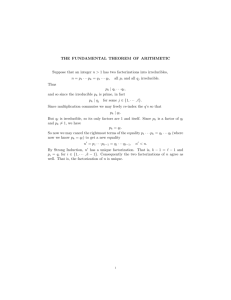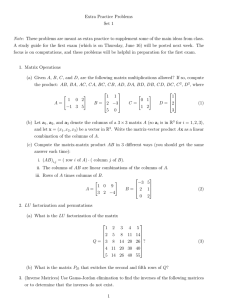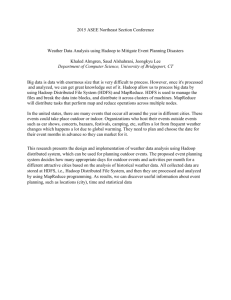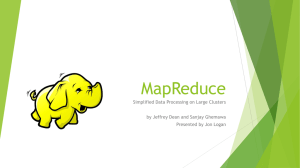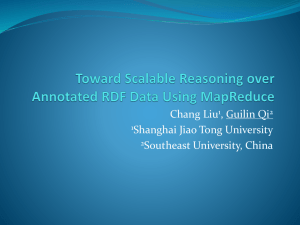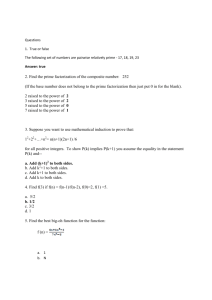Tall and Skinny QR factorizations in MapReduce architectures Paul G. Constantine
advertisement
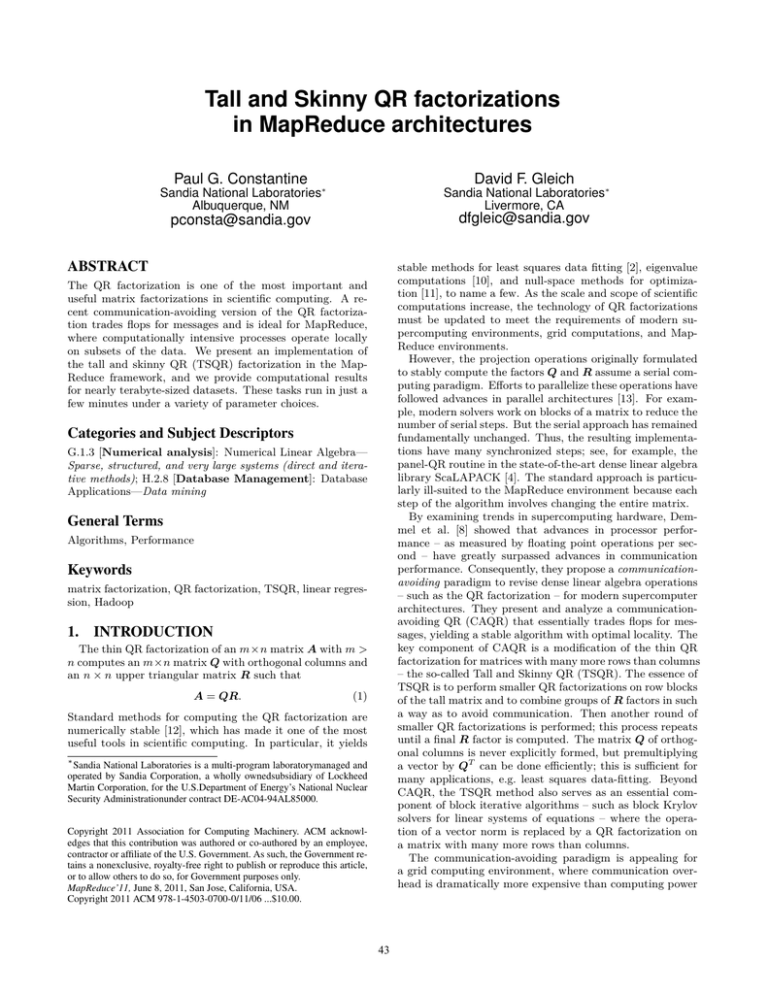
Tall and Skinny QR factorizations
in MapReduce architectures
Paul G. Constantine
David F. Gleich
Sandia National Laboratories∗
Albuquerque, NM
Sandia National Laboratories∗
Livermore, CA
dfgleic@sandia.gov
pconsta@sandia.gov
ABSTRACT
stable methods for least squares data fitting [2], eigenvalue
computations [10], and null-space methods for optimization [11], to name a few. As the scale and scope of scientific
computations increase, the technology of QR factorizations
must be updated to meet the requirements of modern supercomputing environments, grid computations, and MapReduce environments.
However, the projection operations originally formulated
to stably compute the factors Q and R assume a serial computing paradigm. Efforts to parallelize these operations have
followed advances in parallel architectures [13]. For example, modern solvers work on blocks of a matrix to reduce the
number of serial steps. But the serial approach has remained
fundamentally unchanged. Thus, the resulting implementations have many synchronized steps; see, for example, the
panel-QR routine in the state-of-the-art dense linear algebra
library ScaLAPACK [4]. The standard approach is particularly ill-suited to the MapReduce environment because each
step of the algorithm involves changing the entire matrix.
By examining trends in supercomputing hardware, Demmel et al. [8] showed that advances in processor performance – as measured by floating point operations per second – have greatly surpassed advances in communication
performance. Consequently, they propose a communicationavoiding paradigm to revise dense linear algebra operations
– such as the QR factorization – for modern supercomputer
architectures. They present and analyze a communicationavoiding QR (CAQR) that essentially trades flops for messages, yielding a stable algorithm with optimal locality. The
key component of CAQR is a modification of the thin QR
factorization for matrices with many more rows than columns
– the so-called Tall and Skinny QR (TSQR). The essence of
TSQR is to perform smaller QR factorizations on row blocks
of the tall matrix and to combine groups of R factors in such
a way as to avoid communication. Then another round of
smaller QR factorizations is performed; this process repeats
until a final R factor is computed. The matrix Q of orthogonal columns is never explicitly formed, but premultiplying
a vector by QT can be done efficiently; this is sufficient for
many applications, e.g. least squares data-fitting. Beyond
CAQR, the TSQR method also serves as an essential component of block iterative algorithms – such as block Krylov
solvers for linear systems of equations – where the operation of a vector norm is replaced by a QR factorization on
a matrix with many more rows than columns.
The communication-avoiding paradigm is appealing for
a grid computing environment, where communication overhead is dramatically more expensive than computing power
The QR factorization is one of the most important and
useful matrix factorizations in scientific computing. A recent communication-avoiding version of the QR factorization trades flops for messages and is ideal for MapReduce,
where computationally intensive processes operate locally
on subsets of the data. We present an implementation of
the tall and skinny QR (TSQR) factorization in the MapReduce framework, and we provide computational results
for nearly terabyte-sized datasets. These tasks run in just a
few minutes under a variety of parameter choices.
Categories and Subject Descriptors
G.1.3 [Numerical analysis]: Numerical Linear Algebra—
Sparse, structured, and very large systems (direct and iterative methods); H.2.8 [Database Management]: Database
Applications—Data mining
General Terms
Algorithms, Performance
Keywords
matrix factorization, QR factorization, TSQR, linear regression, Hadoop
1.
INTRODUCTION
The thin QR factorization of an m×n matrix A with m >
n computes an m×n matrix Q with orthogonal columns and
an n × n upper triangular matrix R such that
A = QR.
(1)
Standard methods for computing the QR factorization are
numerically stable [12], which has made it one of the most
useful tools in scientific computing. In particular, it yields
∗
Sandia National Laboratories is a multi-program laboratorymanaged and
operated by Sandia Corporation, a wholly ownedsubsidiary of Lockheed
Martin Corporation, for the U.S.Department of Energy’s National Nuclear
Security Administrationunder contract DE-AC04-94AL85000.
Copyright 2011 Association for Computing Machinery. ACM acknowledges that this contribution was authored or co-authored by an employee,
contractor or affiliate of the U.S. Government. As such, the Government retains a nonexclusive, royalty-free right to publish or reproduce this article,
or to allow others to do so, for Government purposes only.
MapReduce’11, June 8, 2011, San Jose, California, USA.
Copyright 2011 ACM 978-1-4503-0700-0/11/06 ...$10.00.
43
This is not yet a QR factorization for A. Note, however,
that a QR factorization of the 4n×n matrix on the right will
produce a QR factorization of A. (Recall that the product
of orthogonal matrices is orthogonal.) That is,
on individual processors. By trading expensive synchronization points for additional local computation, communicationavoiding algorithms often fit into the MapReduce environment [7]. In MapReduce, these algorithms take the computation to the data in-situ, instead of communicating the
data between computers. Here, we present the TSQR algorithm and its implementation in a MapReduce computing
environment. By treating the matrix as an unordered collection of rows, we formulate both the mapping and reducing
step as streaming TSQR factorizations. These approaches
update a local QR factorization in response to a new block
of rows. With this implementation, we can compute the QR
factorization on terabyte scale data sets stored redundantly
on the hard disks of a MapReduce cluster, and the bulk of
the computation is done with data-local operations.
The related work falls into two broad categories: statistical algorithms in MapReduce, and tall-and-skinny QR factorizations in high-performance computing architectures. A
recent proposal in the Apache Mahout package is to implement linear regression – a natural application of the tall-andskinny QR factorization – using a stochastic gradient descent
method [21]. In contrast, our approach allows these problems to be solved exactly when the matrix has a particular
shape; see the conclusion for some ideas about future work
related to Mahout. Another frequently used MapReduce
computation is principal components analysis (PCA). The
standard technique for implementing this algorithm is to
compute the covariance matrix directly. See Section 2.4 for
more about some issues with this approach.
The success and flexibility of the TSQR procedure developed by Demmel et al. [8] has sparked a small revolution
in applications of this technique. It has been implemented
directly inside the MPI framework for parallel codes as a
native reduce operation [14]. This construction allows codes
to use the TSQR procedure optimally on each architecture.
Others have successfully used the TSQR procedure to compute the QR factorization in a grid environment [1] and on
Amazon’s EC2 platform [6].
2.
=Q
z
|
Q2
Q3
{z
8n×4n
n×n
}
8n×4n
1
R5
Q5
R2
.
=
R3
Q6 R 6
|
{z
}
|
{z
}
R4
4n×2n
2n×n
| {z }
4n×n
One final QR factorization of the 2n × n matrix on the right
remains. After that operation,
=Q
z
}|
Q1
Q3
|
{
Q2
A=
{z
8n×4n
Q5
Q7
Q6 |{z}
Q4 | {z } 2n×n
} 4n×2n
R7
|{z}
n×n
is a QR factorization. What this examples shows is that to
produce the matrix R, the only operation required is the QR
factorization of a 2n×n matrix. As stated, Q is the product
of a sequence of three orthogonal matrices. We return to the
issue of computing Q in Sections 2.2 and 2.3
As noted in ref. [8], any sequence or tree of QR factorizations of this form will work. The above example shows how
to compute a QR factorization with maximum parallelism.
(The factorizations of Ai are independent, as are the factor
T
T
izations of RT1 RT2
and RT3 RT4 .) In particular,
suppose that the matrix A is presented one row at a time.
Further, suppose that we have the ability to store 3n rows
of A and compute a QR factorization for these stored rows.
Then the following sequence of four QR factorizations will
produce the R factor:
R1
R2
R3
= Q2 R 2 ;
= Q3 R 3 ;
= Q4 R 4 .
A2
A3
A4
A 1 = Q1 R 1 ;
As an algorithm, this procedure first reads and stores the
2n rows for A1 . It then computes a QR factorization of this
block, yielding an n×n matrix R1 . Next, it reads in another
2n rows for A2 . At this point, its buffer of rows is full, and
consequently, it “compresses” that to a new matrix R2 via
a second QR factorization. This process continues in blocks
of 2n rows until there are no more rows of A left. In a single
equation, it computes:
In this example, each Ai is a 2n × n matrix, but in general,
the idea is that each Ai is a small local matrix. We assume
that Ai is small enough that we can efficiently compute its
QR factorization with the standard algorithm on a single
processor. These independent QR factorizations provide a
factorization of A:
A=
4n×n
R̃ .
|{z}
R
Q̃
|{z}
{z
{
But, suppose for the sake of the example that a 4n × n QR
factorization is itself too large for any single processor. Consequently, we repeat the small QR factorizations for both
2n × n pairs of matrices:
A1
A2
A = .
A3
A4
Q1
Q3
Q4
|
THE TSQR FACTORIZATION
Q2
A=
We now describe the idea behind a TSQR factorization
and its implementation in a MapReduce system. As previously mentioned, this algorithm is a natural fit when only
the R factor is required. The following derivation of the idea
closely parallels ref. [8].
Consider a matrix A with 8n rows and n columns, which
is partitioned as
}|
Q1
R1
R2
R3 .
R4
Q4
=Q
z
Q1
A=
h
I 2n
|
4n×n
44
{z
8n×7n
}|
{
i
I 2n
I 2n
I 2n
} | {z }
Q2
I 2n
}|
{z
7n×5n
Q3
Q4
I 2n
|{z}
} | {z }
5n×3n
3n×n
R .
|{z}
n×n
A1
A1
A2
A2
qr
Q2
R2
Mapper 1
Serial TSQR
A3
A3
qr
Q3
A4
A4
A5
A5
A6
A6
qr
Q6
qr
Q4
R4
emit
qr
Q8
R8
emit
R6
Mapper 2
Serial TSQR
R3
A7
A7
qr
Q7
R7
A8
A8
Figure 1: A pictorial description of the two mappers. The dashed arrows describe reading a block of rows
from the input.
Reducer 1
Serial TSQR
R4
R4
R8
R8
qr
Q
R
Given the explicit or implicit storage of the matrix A, each
mapper in the MapReduce TSQR implementation runs a serial TSQR routine, acquiring the matrix a single row at a
time. After it has acquired all the rows available, it outputs
the R factor for these rows. Each row of the output has a
random key. Thus, the input keys are ignored. Also, each
reducer runs the same serial TSQR procedure. There is no
need for a local "combine" operation because the identity of
each row is ignored and the map already outputs the most
highly reduced form of its data. A high level view of the operations in the map and reduce is shown in Figures 1 and 2.
A complete implementation of this mapper and reducer using the hadoopy Python framework for Hadoop streaming
programs is given in Figure 3.
When this MapReduce program is run with a single reducer, the output from that reducer is the R factor. Using
only one reducer, however, eliminates some opportunities for
parallelism. In the Hadoop file system, for instance, large
files are divided into multiple segments called splits. The
total number of mappers is the number of files multiplied
by the number of splits. In most realistic scenarios, there
will be more than a single file constituting the input matrix
A. This phenomenon often happens for one of two reasons.
The first is that the data were collected in discrete increments, which are analyzed together – this would be the case
for an aggregation of daily log files. The second is that the
data are output by a previous MapReduce job, in which the
number of files is equal to the number of reducers. Using
many mappers and only a single reducer is problematic for
this application because the reducer must compute a serial
TSQR on the output from all the mappers, which could be
a lengthy serial computation. An alternative is to use a
multi-iteration TSQR approach; see Figure 4. When using
two MapReduce iterations, the output from the mappers are
fed into a large set of reducers. The output of these reducers
emit
Figure 2: A pictorial description of the reducer and
the steps involved in its serial TSQR procedure.
We now combine these two computation trees to implement
a TSQR algorithm on a MapReduce computer.
2.1
A TSQR reduction tree for MapReduce
In the previous section, we saw how to compute the R
factor in a QR factorization for a tall-and-skinny matrix
in two scenarios: a maximally parallel computation and a
completely serial computation. To implement a TSQR procedure on a MapReduce architecture, we combine these two
cases.
In this implementation, the matrix exists as a set of rows.
That is, each record, or key/value pair, in the MapReduce
environment is a row identifier and an array containing the
values in the row. This storage implies that a tall-and-skinny
matrix will have many records. Due to the distributed nature of the file systems underlying a MapReduce system, this
matrix will be partitioned across the many different computers and disks constituting the entire MapReduce cluster. In
terms of the examples from the previous section, each submatrix Ai corresponds to a different split of the distributed
data. Also, note that the matrix need not be stored explicitly. In Section 3.5, we describe how to solve a least squares
problem on a single file representing a collection of images.
There, we build the rows of the least-squares matrix directly
from the raw image data.
45
import random, numpy, hadoopy
class SerialTSQR:
def __init__(self,blocksize,isreducer):
self.bsize=blocksize
self.data = []
if isreducer: self.__call__ = self.reducer
else: self.__call__ = self.mapper
ical linear algebra textbooks and is repeated to illustrate
how a QR factorization may be used. Let A = Q̃R̃ be a
full-QR of A. In the full-QR factorization, Q̃ is square and
orthogonal, and R̃ = [RT 0T ]T , where
R is n × n and upper
triangular. Note that Q̃ = Q Q̃2 where Q is the thin-QR
factor. Then, by orthogonality,
T Q b
Rx
,
kb − Axk = kQ̃ b − Q̃ Axk = T
−
0m−n×n Q̃ b
def compress(self):
R = numpy.linalg.qr(numpy.array(self.data),’r’)
# reset data and re-initialize to R
self.data = []
for row in R:
self.data.append([float(v) for v in row])
T
2
for any vector x. Because R is full rank by assumption,
the solution of the linear system Rx = QT b is the solution
of the least squares problem. The value
q of the objective
def collect(self,key,value):
self.data.append(value)
if len(self.data)>self.bsize*len(self.data[0]):
self.compress()
T
2
function at the minimum is kQ̃2 bk = kbk2 − kQT bk .
Using this approach to compute the solution requires the
vector QT b. Computing this vector seemingly requires the
matrix Q, but QT b may be computed without explicitly
forming Q. We illustrate this idea by returning to the example in Section 2. Let A be the 4n × n matrix from the
example, and let b = [ bT1 bT2 bT3 bT4 ]T be partitioned conformally with A. (In a MapReduce environment, this means
that we have the values of b stored with their corresponding
rows of A.) Using the QR factorization from before, note
that
def close(self):
self.compress()
for row in self.data:
key = random.randint(0,2000000000)
yield key, row
def mapper(self,key,value):
self.collect(key,value)
def reducer(self,key,values):
for value in values: self.mapper(key,value)
"
QT b = QT7
if __name__==’__main__’:
mapper = SerialTSQR(blocksize=3,isreducer=False)
reducer = SerialTSQR(blocksize=3,isreducer=True)
hadoopy.run(mapper, reducer)
QT5
# QT1
T
QT2
Q6
QT3
b1
b2
b3 .
b4
QT4
What this expression shows is that outputting QTi bi from
each small QR factorization is enough to compute QT b
without explicitly forming Q.
Figure 3: A complete hadoopy implementation of
the mapper and reducer. See the text for more description.
2.3
The Q factor and a tall-and-skinny SVD
Of course, many applications require the Q factor. Given
R, we can compute Q = AR−1 . This computation is easy
to implement on a MapReduce system. Using a similar idea,
we can also compute the SVD of a tall and skinny matrix
(see ref. [12] for more about the SVD). However, these approaches have numerical stability problems (see ref. [17] for
instance) and require a careful study of the orthogonality of
the computed factors. We hope to investigate these issues
soon.
then becomes the matrix input for another TSQR procedure
– although this iteration can use an identity mapper to eliminate extra work involved in processing the output from the
previous reduce, which is guaranteed not to change the output. As long as the last iteration has only a single reducer,
the algorithm outputs the correct R factor.
The hadoopy implementation in Figure 3 does not contain the logic to handle a multi-stage iteration; please see
our publicly available codes for that implementation. In
both implementations, we did not invest any effort in constructing a custom data partitioner to ensure data locality
between the mappers and reducers in a multi-stage iteration. Instead, we investigated increasing the minimum split
size to reduce the number of mappers; see Section 3.4 for
these experiments.
2.2
T
2.4
Alternative approaches
Normal equations.
An elementary technique to solve a least-squares problem
is to use the normal equations given by the optimality conditions for the least-squares problems:
AT Ax = AT b.
Solving a least-squares problem
Let B = AT A. Then the Cholesky factorization of B is
B = RT R for an upper-triangular matrix R. For a fullrank matrix A, this Cholesky factor R is the same as the
R factor in the QR factorization. Consequently, another
approach to compute R is to compute AT A and compute
a Cholesky factorization. This computation is also easy to
do in a MapReduce environment. However, this approach
has considerable numerical stability issues [19]. In our experiments, it has performance comparable to the TSQR approach, which has good numerical stability assurances.
Thus far, this manuscript has described how to compute
a TSQR factorization and implement that algorithm on a
MapReduce system. This algorithm is a key ingredient in
solving least-squares problems. Consider a full-rank, least
squares problem with a tall-and-skinny matrix A ∈ Rm×n ,
m n:
minimize kb − Axk.
The following derivation mimics that found in many numer-
46
map
A1
emit
R4
R2,2
emit
Reducer 1-2
Serial TSQR
reduce
A
S23
SA(2)
2
R2,3
shuffle
R3
A
S2
reduce
emit
Reducer 1-1
Serial TSQR
reduce
S(1)
R2,1
identity map
emit
Mapper 1-3
Serial TSQR
map
A34
R2
Mapper 1-2
Serial TSQR
map
A3
S1
shuffle
A
reduce
emit
Mapper 1-1
Serial TSQR
map
A2
R1
R
emit
Reducer 2-1
Serial TSQR
emit
Reducer 1-3
Serial TSQR
emit
Mapper 1-4
Serial TSQR
Iteration 1
Iteration 2
Figure 4: A pictorial description of a multiple iteration routine.
Random sampling.
changes when tweaking different parameters. The first set of
experiments shows the difference in performance from each
of the three different Hadoop streaming frameworks. Unsurprisingly, the C++ implementation is the fastest (Table 2). Please see Section 3.2 for additional discussion on
these frameworks. The next two sets of experiments investigate the effect of the local block size and Hadoopy split
size on the performance. The block size parameter determines the maximum size of a local QR factorization; and
the split size determines the number of Hadoop mappers
launched. The best performance results from a large, but
not too large, block size (Table 3) and a large split size (Table 4). The final experiment uses the TSQR routine to solve
a least squares regression problem and find the principal
components of the tinyimages dataset [18], a 230 GB collection of nearly 80,000,000 small pictures. Using our slowest
framework, Dumbo, we can solve both of these problems in
around 30 minutes and project the C++ code would take
5-8 minutes.
All of the experiments are performed on a Hadoop cluster
with 64 nodes. Each node has a single quad-core Intel Core
i7-920 processor, 12 GB of RAM, and 4 2TB 7200 RPM hard
disks. The nodes are split between two racks. The within
rack connections are Gigabit Ethernet, and there is a single
10 Gigabit connection between racks.
Another approach is to employ random sampling of the
matrix, or a random projection of the matrix (see ref. [9],
and other references within). The idea is that most of the
important quantities in a least-squares problem or QR factorization lie in a low-dimensional space, which can be obtained by randomly sampling rows of the matrix after an
appropriate projection. These algorithms have rigorous approximation bounds and failure probabilities. However, using a random sampling technique still requires touching all
the entries of the matrix. In our experiments, we observe
that the additional work performed in the TSQR approach
does not consume much additional time, and hence, we have
not investigated randomized techniques, because the deterministic techniques have sufficient performance.
3.
EXPERIMENTS
We implemented the TSQR algorithm outlined in the previous section in Hadoop 0.21 [20] streaming. Hadoop streaming is a simple interface to a MapReduce system, which pipes
a stream of key-value pairs to and from an arbitrary program via the standard input and output streams. We constructed this implementation using three different interfaces
to Hadoop streaming: the Dumbo python interface [3], the
hadoopy python interface [23], and a new custom C++ interface. The two python frameworks provide an easy-to-use
environment and a rich set of numerical libraries via the
numpy Python package [15]. The C++ interface can be
viewed as a reference point for any Hadoop streaming approach. In the future, we hope to evaluation against other
TSQR approaches in MPI and grid environments.
We begin by describing our suite of synthetic test matrices (Table 1) that we use to evaluate the performance of the
TSQR algorithms (Section 3.1). These problems are used to
provide insight into how the performance of the algorithm
3.1
Synthetic problems
In order to construct large scale synthetic problems, we
implement the data generators directly in MapReduce using
a Dumbo and numpy implementation. Let M be the number
of mappers used, m be the number of rows in the final matrix and n be the number of columns. We deterministically
construct R as an n × n upper-triangular matrix of all ones.
This choice lets us quickly check that the computed answers
are correct, which they were for all experiments here. In the
first iteration of the construction, each mapper is assigned
47
dBytes data. Once a key-value pair has been decoded, the
three streaming implementations run the same algorithm as
illustrated in Figure 3. On output, they re-encode the data
for each row in big endian byte order.
In Table 2, we show the performance of the three implementations for the test matrix with 500 columns. This table
shows the performance of three different Hadoop streaming
frameworks using the TSQR algorithm. The QR columns
give the total time spent doing local QR operations in each
framework. The test matrix has 500 columns and uses a
two-iteration approach with 250 reducers in the first iteration and 1 reducer in the second. We used a two-iteration
TSQR procedure, and show the total seconds taken by the
entire computation, each iteration, and the individual map
and reduce steps. Note that the mappers and reducers often
do bits of work in parallel, and thus, the sum of the map
and reduce time for an iteration is more than the total iteration time. Also, we show the sum of time spent doing the
QR factorizations. These experiments show that hadoopy
is a more efficient Python framework for Hadoop streaming
than Dumbo. Additionally, the hadoopy framework takes
roughly twice as long as a C++ implementation. It seems
the hadoopy linear algebra (using numpy and ATLAS [22])
routines incur a significantly higher overhead than the C++
code (using ATLAS), which could bias the comparison.
Table 1: The synthetic test matrices we use in this
manuscript. See §3.1.
Rows
Columns
HDFS Size
Col. sums
(secs.)
1,000,000,000
500,000,000
100,000,000
50,000,000
50
100
500
1000
453.3
423.3
381.2
375.8
145
161
128
127
GB
GB
GB
GB
M/m rows to generate. Then each mapper generates a local,
random orthogonal matrix Qi with 2n rows. This matrix is
applied to R, and the resulting 2n rows are output. The
mappers repeat this process until they have output all m
rows. The output keys for these rows are random. The reduce step is just an identity reducer. However, with the random output keys, the reduce step is a random permutation
of these rows, which is another orthogonal matrix transform.
On subsequent iterations, the mappers read in up to 2r rows,
and perform yet another orthogonal transformation with another random Qi . Overall, there are three total iterations:
Mapper 1 to generate an initial matrix with a known R and
local orthogonal transforms; Reducer 1 to perform a permutation of the rows; Mappers 2 and 3 to further transform
the matrix with additional orthogonal factors; and Reducers 2 and 3 to perform additional permutations. The result
is not a uniformly sampled random matrix with R as the
QR factor, but an easy-to-implement approximation. See
Table 1 for the details on the number of rows and columns
in the test problems. They are all constructed to be around
400GB in size, and with many more rows than columns. The
final number of reducers is 1000, and so each matrix consists of 1000 separate files, stored in HDFS. We also provide
the time of a reference streaming computation on each matrix. This computation is the total time it takes to compute
the column sums using our C++ streaming framework (described next), and approximates the minimum time to do
one non-trivial MapReduce iteration. The reported times
were consistent across three repetitions of the experiment.
(We thank James Demmel for suggesting this performance
benchmark.)
3.2
3.3
Prototyping frameworks
Each of the three streaming frameworks receive key and
values pairs as binary encoded “TypedBytes” [3]. These
TypedBytes allow binary data to be passed between Hadoop
and Hadoop streaming mappers and reducers, and include
integer, floating point, and array primitives. The values are
encoded with a big endian byte order following the Java convention. These values must then be converted into the native
byte order before they can be used, and this conversion operation occupies the majority of the time in decoding Type-
Iter 1
Map
Dumbo
hadoopy
C++
Local block-sizes
The serial TSQR procedure implemented by all the mappers and reducers has a block size parameter to determine
how many rows to read before computing a local QR factorization. These block size parameters are expressed in terms
of an integer multiple of the number of columns. For instance, a block size of 3 means that the mappers will read
3 rows for each column before computing a local QR factorization. We think of a block as an n × n chuck of the
matrix, where n is the number of columns. As we vary the
number of columns in the matrix, changing the block size
can cause a meaningful performance difference; see Table 3.
This computation uses a two iteration TSQR tree with our
C++ code; it shows increasing the blocksize increases performance, but making it too large reduces performance. Each
row in the table gives the number of columns in the matrix,
the number of mappers used for the first iteration, and the
time in seconds for each the two iterations. The two iteration algorithm used 250 reducers in the first iteration and 1
reducer in the second iteration.
The serial TSQR must repeat one block of work for each
subsequent QR compression step. Consequently, a small
block size causes a significant fraction of the total work to
be redundant. The problem with a large block size is that it
requires higher memory traffic. (Although, this could be improved with a better implementation of QR in ATLAS [8].)
Table 2: Results for the three Hadoop streaming frameworks. See §3.2.
Iter 2
Red.
Total
Map
Red.
Total
Overall
Secs.
QR (s.)
Secs.
QR (s.)
Secs.
Secs.
Secs.
QR (s.)
Secs.
Secs.
911
581
326
67725
70909
15809
884
565
328
2160
2263
485
960
612
350
5
5
5
214
112
34
80
81
15
217
118
37
1177
730
387
48
Table 3: Results when varying block size. The best
performance results are bolded. See §3.3 for details.
Iter. 1
Iter. 2
Cols.
Blks.
Maps
Secs.
Secs.
50
—
—
—
—
—
—
—
2
3
5
10
20
50
100
200
8000
—
—
—
—
—
—
—
424
399
408
401
396
406
380
395
21
19
19
19
20
18
19
19
100
—
—
—
—
2
3
5
10
20
7000
—
—
—
—
410
384
390
372
374
21
21
22
22
22
1000
—
—
—
—
2
3
5
10
20
6000
—
—
—
—
493
432
422
430
434
199
169
154
202
202
3.4
Table 4: Results when varying split size. See §3.4.
Cols.
Iters.
Split
Maps
Secs.
(MB)
50
—
—
1
—
—
64
256
512
8000
2000
1000
388
184
149
—
—
—
2
—
—
64
256
512
8000
2000
1000
425
220
191
1000
1
512
1000
666
—
—
—
2
—
—
64
256
512
6000
2000
1000
590
432
337
3.5
Tinyimages: regression and PCA
Our final experiment shows this algorithm applied to a
real world dataset. The tinyimages collection is a set of almost 80,000,000 images. Each image is 32-by-32 pixels. The
image collection is stored in a single file, where each 3072
byte segment consists of the red, green, and blue values for
each of the 1024 pixels in the image. We wrote a custom
Hadoop InputFormat to read this file directly and transmit the data to our Hadoop streaming programs as a set of
bytes. We used the Dumbo python framework for these experiments. In the following two experiments, we translated
all the color pixels into shades of gray. Consequently, this
dataset represents an 79,302,017-by-1024 matrix.
We first solved a regression problem by trying to predict
the sum of red-pixel values in each image as a linear combination of the gray values in each image. Formally, if ri is the
sum of the red components in all pixels of image i, and Gi,j
is the gray value
P of the
P jth pixel in image i, then we wanted
to find min i (ri − j Gi,j sj )2 . There is no particular importance to this regression problem, we use it merely as a
demonstration.
The coefficients sj are displayed as an image at the right.
They reveal regions of the image that are not as important
in determining the overall red
component of an image. The
color scale varies from lightblue (strongly negative) to blue
(0) and red (strongly positive).
The computation took 30 minutes using the Dumbo framework and a two-iteration job with 250 intermediate reducers.
We also solved a principal component problem to find a
principal component basis for each image. Let G be matrix
of Gi,j ’s from the regression and let ui be the mean of the ith
row in G. The principal components of the images are given
by the right singular vectors of the matrix G − ueT where u
are all of the mean values as a vector and e is the 1024-by-1
vector of ones. That is, let G − ueT = U ΣV T be the SVD,
then the principal components are the columns of V . We
compute V by first doing a TSQR of G − ueT , and then
computing an SVD of the final R, which is a small 1024by-1024 matrix. The principal components are plotted as
images in Figure 5. These images show a reasonable basis
for images and are reminiscent of the basis in a discrete
cosine transform.
Split size
There are three factors that control the TSQR tree on
Hadoop: the number of mappers, the number of reducers,
and the number of iterations. In this section, we investigate the trade-off between decreasing the number of mappers, which is done by increasing the minimum split size in
HDFS, and using additional iterations. Using additional iterations provides the opportunity to exploit parallelism via
a reduction tree. Table 4 show the total computation time
for our C++ code when used with various split sizes and
one or two iterations. The block size used was the best performing case from the previous experiment. Each row states
the number of columns, the number of iterations used (for
two iterations, we used 250 reducers in the first iteration),
the split size, and the total computation time. With a split
size of 512 MB, each mapper consumes an entire input file
of the matrix (recall that the matrices are constructed by
1000 reducers, and hence 1000 files). The two iteration test
used 250 reducers in the first iteration and 1 reducer in the
second iteration. The one iteration test used 1 reducer in
the first iteration, which is required to get the correct final
answer. (In the 1000 column test, using a smaller split size
of 64 or 256 MB generated too much data from the mappers
for a single reducer to handle efficiently.)
The results are different between 50 columns and 1000
columns. With 50 columns, a one iteration approach is
faster, and increasing the split size dramatically reduces the
computation time. This results from two intertwined behaviors: first, using a larger split size sends less data to the final
reducer, making it run faster; and second, using a larger split
size reduces the overhead with Hadoop launching additional
map tasks. With 1000 columns, the two iteration approach
is faster. This happens because each R matrix output by the
mappers is 400 times larger than with the 50 column experiment. Consequently, the single reducer takes much longer in
the one iteration case. Using an additional iteration allows
us to handle this reduction with more parallelism.
49
(dubbed snapshots [16]) – each computed at its respective
input parameters. Storing and managing the terascale data
from these solutions is itself challenging, and the hard disk
storage of MapReduce is a natural fit.
1
1
0.8
0.8
Fraction of variance
Fraction of variance
5.
0.6
0.4
0
0.6
0.4
0.2
0.2
20
40
60
80
Principal Components
100
0
200
400
600
800
Principal Components
1000
Figure 5: The 16 most important principal component basis functions (by rows) and the amount of
variance explained by the top 100 (bottom left) and
all principal components (bottom right).
4.
CONCLUSION
In this manuscript, we have illustrated the ability of MapReduce architectures to solve massive least-squares problems through a tall and skinny QR factorization. We choose
to implement these algorithms in a simple Hadoop streaming framework to provide prototype implementations so that
others can easily adapt the algorithms to their particular
problem. These codes are all available online.1 We envision that the TSQR paradigm will find a place in blockanalogues of the various iterative methods in the Mahout
project. These methods are based on block analogues of the
Lanczos process, which replace vector normalization steps
with QR factorizations. Because the TSQR routine solves
linear regression problems, it can also serve as the leastsquares sub-routine for an iteratively reweighted least-squares
algorithm for fitting general linear models.
A key motivation for our MapReduce TSQR implementation comes from a residual minimizing model reduction
method [5] for approximating the output of a parameterized
differential equation model. Methods for constructing reduced order models typically involve a collection of solutions
1
REFERENCES
[1] E. Agullo, C. Coti, J. Dongarra, T. Herault, and J. Langem.
QR factorization of tall and skinny matrices in a grid
computing environment. In Parallel Distributed Processing
(IPDPS), 2010 IEEE International Symposium on, pages 1
–11, April 2010.
[2] Å. Björck. Numerical Methods for Least Squares Problems.
SIAM, Philadelphia, Penn., 1996.
[3] K. Bosteels. Fuzzy techniques in the usage and construction of
comparison measures for music objects, 2009.
[4] J. Choi, J. Demmel, I. S. Dhillon, J. Dongarra, S. Ostrouchov,
A. Petitet, K. Stanley, D. W. Walker, and R. C. Whaley.
ScaLAPACK: A portable linear algebra library for distributed
memory computers - design issues and performance. PARA,
pages 95–106, 1995.
[5] P. G. Constantine and Q. Wang. Residual minimizing model
reduction for parameterized nonlinear dynamical systems,
arxiv:1012.0351, 2010.
[6] B. Dagnon and B. Hindman. TSQR on EC2 using the Nexus
substrate. http://www.cs.berkeley.edu/~agearh/cs267.sp10/
files/writeup_dagnon.pdf, 2010. Class Project writeup for
CS267 and University of California Berkeley.
[7] J. Dean and S. Ghemawat. MapReduce: Simplified data
processing on large clusters. In Proceedings of the 6th
Symposium on Operating Systems Design and
Implementation (OSDI2004), pages 137–150, 2004.
[8] J. Demmel, L. Grigori, M. Hoemmen, and J. Langou.
Communication-avoiding parallel and sequential QR
factorizations. arXiv, 0806.2159, 2008.
[9] P. Drineas, M. W. Mahoney, S. Muthukrishnan, and T. Sarlós.
Faster least squares approximation. Numerische Mathematik,
117(2):219–249, 2011.
[10] J. G. F. Francis. The QR transformation a unitary analogue to
the LR transformation – part 1. The Computer Journal,
4:265–271, 1961.
[11] P. E. Gill, W. Murray, and M. H. Wright. Practical
Optimization. Academic Press, 1981.
[12] G. H. Golub and C. F. van Loan. Matrix Computations. The
Johns Hopkins University Press, third edition, October 1996.
[13] D. Heller. A survey of parallel algorithms in numerical linear
algebra. SIAM Rev., 20:740–777, 1978.
[14] J. Langou. Computing the R of the QR factorization of tall
and skinny matrix using mpi_reduce. arXiv,
math.NA:1002.4250, 2010.
[15] T. E. Oliphant. Guide to NumPy. Provo, UT, Mar. 2006.
[16] L. Sirovich. Turbulence and the dynamics of coherent
structures. Part 1: Coherent structures. Quar, 45(3):561–571,
1987.
[17] A. Stathopoulos and K. Wu. A block orthogonalization
procedure with constant synchronization requirements. SIAM
J. Sci. Comput., 23:2165–2182, June 2001.
[18] A. Torralba, R. Fergus, and W. Freeman. 80 million tiny
images: A large data set for nonparametric object and scene
recognition. Pattern Analysis and Machine Intelligence,
IEEE Transactions on, 30(11):1958 –1970, November 2008.
[19] L. N. Trefethen and D. I. Bau. Numerical Linear Algebra.
SIAM, Philadelphia, 1997.
[20] Various. Hadoop version 0.21. http://hadoop.apache.org, 2010.
[21] F. Wang. Implement linear regression.
https://issues.apache.org/jira/browse/MAHOUT-529.
Mahout-529 JIRA, accessed on February 10, 2011.
[22] R. C. Whaley and J. Dongarra. Automatically tuned linear
algebra software. In SuperComputing 1998: High
Performance Networking and Computing, 1998.
[23] B. White. hadoopy. http://bwhite.github.com/hadoopy.
Acknowledgments. We are exceedingly grateful to Mark Hoemmen
for many discussions about the TSQR factorization. We would also
like to thank James Demmel for suggesting examining the reference
streaming time. Finally, we are happy to acknowledge the fellow
MapReduce “computers” at Sandia for general Hadoop help: Craig
Ulmer, Todd Plantenga, Justin Basilico, Art Munson, and Tamara G.
Kolda.
See http://www.github.com/dgleich/mrtsqr.
50

